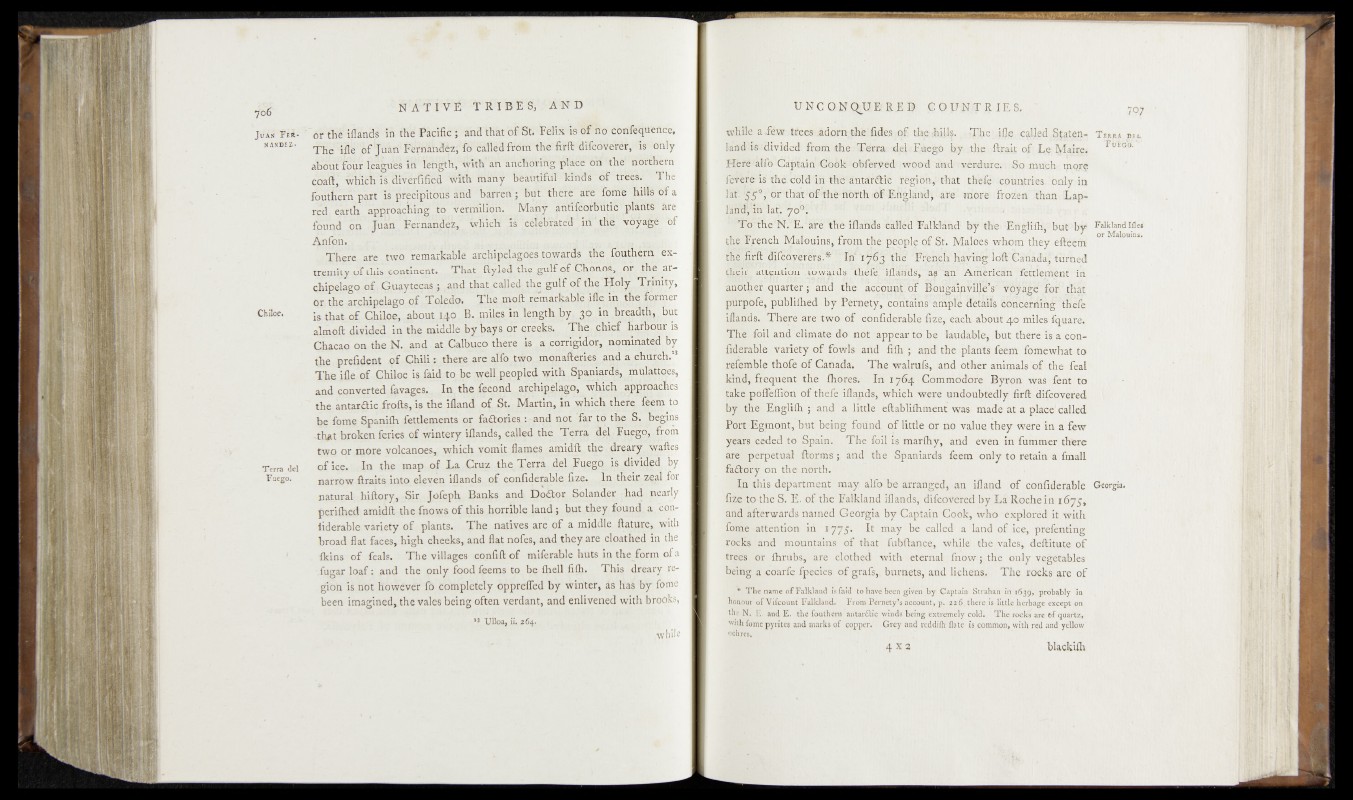
f o b
Jditî FeL
Chiloe.
Terra del
Fnego.
ttté1 !ft the fNfeîI&f ini ÎMt of St. Félix is of no cbtfft^ufeflCfe.
® 'M e j fW a ’ tÉÿîiüfèzj fo called ftôtïi the firft'drtëâtféHr,' is? only
B* Ü M h ^ tK
cbari,' wiiiéh~is îliverlifoeâ •’with many beai^ffvfl kinds The
foûthern part isJprecipitous and barren; but tbàr.e afe fome bills of a
red earth approaching to vermillon. Many antifcorbiitic plants $re
fouijd bn Juan Fernande^ which is cétebratéd ( vo^agëBf
Anfon. , i
There are two remarkable archipelagoes towards ^t^^fouthern g&-
tremity of tljjs continent. That ftyle^ the gulf of (^on^^pr^thefar-
qhipelago of, Quaytecas ; tajnd jthat: gujfq£
Or.the archipelago of Toledo. The,rnoft remarkableifle^ri^the fermer
is that of Ghiloe, about 140 B . pi_i|^ln1engtfi I | | S | | 1 g B B R £ ? }
almoft divided in the middle by bays <>? 5 ^ 0Ur is
Chacao on the N. and at Calbnco tjhére is &a c^rfigi^or, nomujated by
the prefident of Chili : there are
Thelfle of Ghiloe is faid ta be well peopled vyjrii Spanj^ç, jai^ttcfes,
and converted lavages. In, the fécond .arch^l/^^w^^^iroaches
the antaraic frpfts, is the iiland of St. Martin, in w h i q h t0
be fome Spanilh feulements. oy factories, :: aqd. pot 'far to tfe-S-j^begins
th#it broken feries of wintery iflands, called the Terr^ del ^F^go^, from
tvyo or more volcanoes, which vomit flames aipidft the !.dre^y^ji5r|i,i|es
of içel, -;..In the map of La Cruz the Terra del Fi^egp J ^ ^ v ^ d by
narrow ftraits into eleven iflands of confidemble fize. their^z^al for
natural hiftory, Sir Jofeph Banks and DoCtor Soland,er had-pearly
perifhed araidft the fnows of this horrible land ,; but they .found^ S 11-
liderable variety of plants. The natives are of a middle ftat,n^, ®|th
broad flat faces, high cheeks, and flat nofes, and they are cloathed in the
(kins of feak. The villages eonfiftof miferable huts in the form of a
iugar loaf : and the only food feems to be fhell fife. This dreary region
is not however lb Completely Opprefled by winter, às haè by feme
been imagined, the vales being often verdant, and enlivened with brooks,
while
« UUoa, ii. 264.
wiHilc a fe&yyrees a^^n the fidegraf theubiils. Theilie called Staten- Tmi del
land-is:'divided from the Terra del Fuego by the ftrajt of Le Maire. ruEG0'
Here'ilfo Captain Cook obferved wp'o'd and (verdure. So much more
fevere is the cold in the antarCt-ie region, that thefe countries only in
lat. trf^f'bf^h^^bf 'ftie^ferth <of England, are more--frozen than Lap-
JatrdyMi laSf;yer rv 1
i f l a f t d s JFalMahcT* hyfftie^bgffillplmtPby Falkland Me*
theSrench Malou'ms^ from the’,-j&op^pf St. Mai pies’- whom they"'effegutf • °Bm*’
thejGtn "OTeQ^ers**1 ' Tpi jdfxm Frsenb|i^Kayibfgilo'ft'fea,nadaf'turned
tljieir attention .towards theie, ifl^d^, apJ an* Amferica’h femerffint1 in -
another quarter; ana the ' aecpun|';'bf Bougainvilje’s^ voyage' foP thSt
purpofe, publilhed by jPernety^c^^i^Sli^Tl peraffs concerning'’thefe
iflands. There are two of ufqnfiderable fizer, .ea^S about 40 miles fquare.
Th|; foil and"1 climate do nof-appear to be 1 laudable; ?bnt there Is a,cOn- ,
flipable variety of fowls- and fifh -; and the plants,feem; fomewhat to
rej^mble thofe of Canada. The walrufs,. and other animals'of' the feal-
kind, frequent the fhores.' In 1764 Commodore Byrpn was fent to
take ppfleffibn of thefe iflapds, whi'eh were undoubtedly firft difeovered '
by the Englilh ;■ and' a little eftablifhment was made at a place'Called
Port EgmQnt, but being found of little or no value they were in a few
years ceded to Spain. The foils' tnarfhy, and &ven in fummer ttere
are; perpetual ftdrms; and the Spaniards feem only to retain a fmall
faftory on the north.
In this department may alfo be arranged, an ifland of confiderable Georgia,
fize to the S. E. of the Falkland iflands, difeovered by La Roche in
and afterwards named Georgia by Captain Cook, who 'explored it with
feme -attention in 1775. It may be called a land of,ice, prefenting
rocks and mountains of that fubftance, while the vales, deftitute of
trees or fhrubs, are clothed with eternal fnow; the only Vegetables
being a coarfe fpecies of grafs,^ burnets, and lichens. The rocks are of .
* The name of Falkland is faid to have been given by Captain Stratum u£o$39, probably in
honour of Vifcount Falkland. From Pernety’s account, p. zz6, there is little herbage except on
the N. C. and Eh the fouthern antarftic winds1 being extremely cold. The rocks are Of quartz,
'vith fome pyrites and marks of copper. Grey and reddifh date is common, with red and yellow'
ochres.
4X2 blackifh